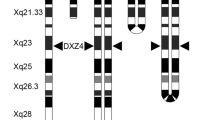Summary
Two dicentric human chromosomes were investigated with light and electron microscopic techniques. One chromosome, with a translocation tdic(5;13)(p12;p12), behaved as a dicentric in about half the cells: it had two primary constrictions; C- and Cd-banding showed two centromeres; and the CREST antikinetochore antibody reacted with the two centromeres with equal affinity. Electron microscopic analysis of sectioned metaphases showed that the dicentric could develop kinetochores at both centromeres simultaneously. The other dicentric chromosome, tdic(21;21)(q22;q22), occasionally showed two primary constrictions, but both C-and Cd-banding distinguished between an active and an inactive centromere, and the CREST antibody reacted only weakly with the inactive centromere. Electron microscopy showed kinetochore development at only one centromere.
Similar content being viewed by others
References
Balczon RD, Brinkley BR (1987) Tubulin interaction with kinetochore proteins: analysis by in vitro assembly and chemical cross-linking. J Cell Biol 105:855–862
Brenner S, Pepper D, Berns MW, Tan E, Brinkley BR (1981) Kinetochore structure, duplication, and distribution in mammalian cells: analysis by human autoantibodies from scleroderma patients. J Cell Biol 91:95–102
Brinkley BR, Murphy P, Richardson LC (1967) Procedure for embedding in situ selected cells cultured in vitro. J Cell Biol 35:279–283
Dewald GW, Boros SJ, Conroy MM, Dahl RJ, Spurbeck JL, Vitek HA (1979) A tdic(5;15)(p13;p11) chromosome showing variation for constriction in the centrometric regions in a patient with the cri du chat syndrome. Cytogenet Cell Genet 24:15–26
Earnshaw WC, Migeon BR (1985) Three related centromere proteins are absent from the inactive centromere of a stable isodicentric chromosome. Chromosoma 92:290–296
Earnshaw WC, Sullivan KF, Machlin PS, Cooke CA, Kaiser DA, Pollard TD, Rothfield NF, Cleveland DW (1987) Molecular cloning of cDNA for CENP-B, the major human centromere autoantigen. J Cell Biol 104:817–829
Eiberg H (1974) New selective Giemsa technique for human chromosomes, Cd staining. Nature 248:255
Hsu TC, Pathak S, Chen TR (1975) The possibility of latent centromeres and a proposed nomenclature system for total chromosome and whole arm translocations. Cytogenet Cell Genet 15:41–49
John B, Freeman M (1975) Causes and consequences of Robertsonian exchange. Chromosoma 52:123–136
Lica LM, Narayanswami S, Hamkalo BA (1986) Mouse satellite DNA, centromere structure, and sister chromatid pairing. J Cell Biol 103:1145–1151
Maraschio P, Zuffardi O, Lo Curto F (1980) Cd bands and centromeric function in dicentric chromosomes. Hum Genet 54:265–267
Mazia D, Schatten G, Sale W (1975) Adhesion of cells to surfaces coated with polylysine. J Cell Biol 66:198–200
Merry DE, Pathak S, Hsu TC, Brinkley BR (1985) Antikinetochore antibodies: use as probes for inactive centromeres. Am J Hum Genet 37:425–430
Moens PB, Moens T (1981) Computer measurements and graphics of three-dimensional cellular ultrastructure. J Ultrastruct Res 75:131–141
Moroi Y, Peebles C, Fritzler MJ, Steigerwald J, Tan EM (1980) Autoantibody to centromere (kinetochore) in scleroderma sera. Proc Natl Acad Sci USA 77:1627–1631
Niebuhr E (1972a) Dicentric and monocentric translocations in man. Humangenetik 16:217–226
Niebuhr E (1972b) A 45,XX,5-,13-,dic+ karyotype in a case of cridu-chat syndrome. Cytogenetics 11:165–177
Niebuhr E (1974) Down's syndrome. The possibility of a pathogenetic segment on chromosome no. 21. Humangenetik 21:99–101
Peretti D, Maraschio P, Lambiase S, Lo Curto F, Zuffardi O (1986) Indirect immunofluorescence of inactive centromeres as indicator of centromeric function. Hum Genet 73:12–16
Rattner JB, Lin CC (1985) Centromere organization in chromosomes of the mouse. Chromosoma 92:325–329
Stenman S, Rosenqvist M, Ringertz NR (1975) Preparation and spread of unfixed metaphase chromosomes for immunofluorescence staining of nuclear antigen. Exp Cell Res 90:87–94
Therman E, Trunca C, Kuhn EM, Sarto GE (1986) Dicentric chromosomes and the inactivation of the centromere. Hum Genet 72:191–195
Vig BK (1981) Sequence of centromere separation: analysis of mitotic chromosomes in man. Hum Genet 57:247–252
Vig BK (1984) Sequence of centromere separation: orderly separation of multicentric chromosomes in mouse L cells. Chromosoma 90:39–45
Author information
Authors and Affiliations
Rights and permissions
About this article
Cite this article
Wandall, A. Kinetochore development in two dicentric chromosomes in man. Hum Genet 82, 137–141 (1989). https://doi.org/10.1007/BF00284046
Received:
Revised:
Issue Date:
DOI: https://doi.org/10.1007/BF00284046




